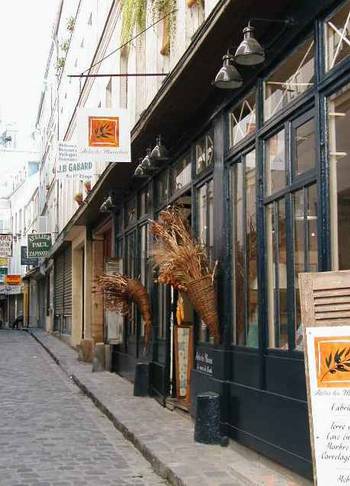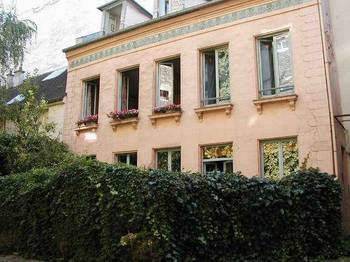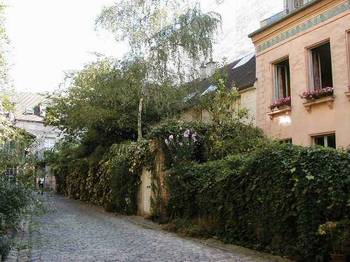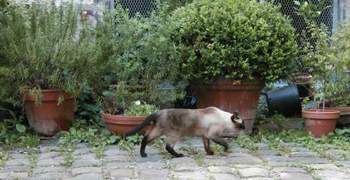Sunday, August 26We've come to the realization that we had been shortchanging the area around the Bastille. This happened because a few years ago, when we went to the Place de la Bastille for the "bal" on Bastille Day's eve we were not impressed with the crowd, and we felt a bit unsafe. But the Thirza Vallois book, Around and About Paris: from the Guillotine to the Bastille Opera - The 8th-12th Arrondisements, convinced me that we had to give that part of the 11th arrondisement another chance. So, off on the number 8 Métro we went. Here (upper right) you see a couple of musicians invaded our Métro car. We sometimes have mixed feelings about this kind of invasion, particularly if the musicians are not good and we're trapped, forced to wince at their mistakes. Tom winces at the sight of an accordion, but even he has to admit that in the hands of a truly skilled musician, an accordion is not a bad thing. Sometimes, like this time, the musicians are really good, and it is a real treat to hear them. When this happens, we give them money when they pass the hat. (If they are poor musicians, we give them nothing. We don't want to give them false encouragement.) On the whole, this kind of occupation is far better than picking pockets, we think. Well, these two fellows were playing jazz (yes, jazz on the accordion!) and they were good. From Place de la Bastille we went east on the rue Faubourg St. Antoine -- formerly the home of extreme Republicans, the sans-culottes, the real die-hard revolutionaries. And many, many of them did die. Narrow little alleys open up onto the rue Faubourg St. Antoine. These were home to the Auvergnats, who first came to Paris to sell coal and settled as scrap metal dealers, water sellers, charcoal merchants, and eventually wood workers and café owners. Thirza maintains that the Auvergnats still are in control of the café industry in Paris. Places like the Passage du Chantier and the Cour de l'Etoile d'Or were, not too long ago, notorious slums. Now eastern Paris is being gentrified, we're told, and while I'm not sure if we saw a lot of gentry, there were many signs of a hard-working middle class (custom and reproduction furniture workshops) and comfortable middle class residential life in these charming little streets. |

Passage du Chantier
Cour de l'Etoile d'Or (above and below)
|
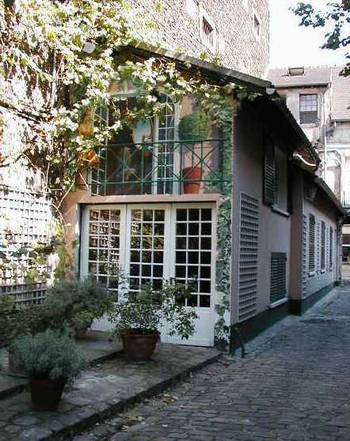 |
|
| Sundial on a wall in the Cour de l'Etoile d'Or, on
an 18th century house. Thirza says the area was also home to Jews who fled as the Ottoman Empire was failing, and later the area attracted Jews who immigrated from Eastern Europe. Their business was often fabric and affordable clothing. One can see traces of that legacy here and there, and in fact Tom and I passed a workshop window in which a couple dozen automatic sewing machines were working away -- doing embroidery, I think. The area still is full of small businesses and their workshops. |
 |
| Siamese patrols the Cour de l'Etoile d'Or. Tom found a great spot for us to have lunch, just off the avenue Faubourg St. Antoine on the rue de Citeaux. From nearly a block away, he spotted someone going into a restaurant and it just looked right. It was only noon -- on the early side for lunch in Paris -- but when we reached the front windows of the place (called "L'Ebauchoir") we could see that some French people were already eating there. This is always a good sign. We went in, had a lovely meal, at a bargain price of 75 francs each for three courses, and were thoroughly fortified for the rest of our afternoon of exploring the 11th. L'Ebauchoir, by the way, is just over the line in the 12th arrondisement.
|
|
| This café (at right, in the 11th), closed for
August, bears a sign that testifies to its past as an Auvergnat establishment -- it still
advertises wood and charcoal, as well as wine and other alcoholic beverages. North of the Faubourg St. Antoine we walked to the Eglise St. Marguerite, an old parish church that has a fascinating history as the site of a miracle that took place in the 19th century when a woman who had been crippled for 20 years was miraculously cured there. Unfortunately the church was closed, probably for security reasons because this part of the 11th is still a bit rough. We walked up to the Place Léon Blum (named for the man who brought the 40 hour work week and much more humane working conditions to France) where the town hall for the 11th is located. Then we went west to a charming area not far from the Canal St. Martin. There many of the old ateliers (workshops) have been turned into lofts and film making establishments, art galleries, etc. Here, on rue Nicolas Appert is a mural depicting, according to Thirza, Victor Hugo "rubbing shoulders with Sophocles, Shakespeare, Molière, and Marivaux, and with later playwrights, J. P. Sartre and Samuel Beckett." The artist, Phillippe Rebuffet, included himself on the right. |
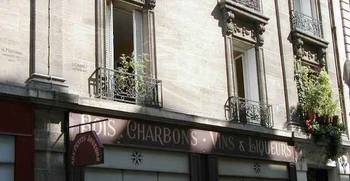 |
 |
|
| More lovely artwork on the Passage du Chantier. Miss Tie has been immortalized, stalking on her favorite trattoir. | 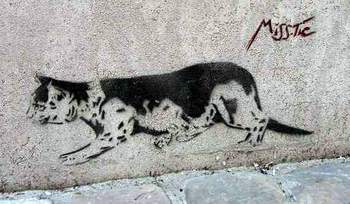 |
